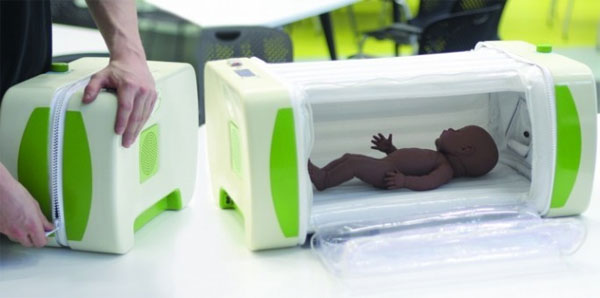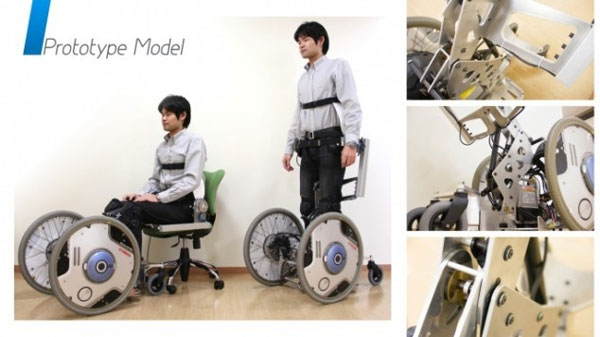The James Dyson Award 2014 was owned
James Dyson Award is an international creative award held annually to honor student inventors whose inventions are not only useful and close to life, but also inspire the designers of the same hybrid
Incubating premature babies MOM
The first prize of the 2014 James Dyson Award went to 23-year-old designer James Robert, from Loughborough University (UK), with a mobile premature baby incubator named 'MOM'.

Incubators are equipped with heating components to help keep babies warm. When you need to keep your child warm, the area where the baby will be placed will be inflated and after use, take a break to fold it neatly. Although MOM is electrically operated, it also has a spare battery available to maintain a child-friendly warm-up system for 24 hours if a power failure occurs. Inside the incubator is a light therapy unit to treat babies with jaundice. Information on temperature and humidity inside the incubator will be displayed on the upper screen, allowing caregivers to easily monitor. In case the temperature and humidity exceed the standard, the alarm will ring for them to correct.
According to the inventor Robert, compared to the current premature young incubator, which costs about $ 47,500, the MOM incubator offers the same feature but the production cost is only about $ 400 and easily transported to anywhere. . This low-cost device can replace fixed incubators at hospitals and promises to benefit remote rural areas that often lack medical equipment. With $ 45,000 in bonuses, Robert can invest in making and testing commercially capable versions of MOM.
Meanwhile, 3 three inventions won second prize with the prize of 7,500 USD / prize from James Dyson fund:
QOLO - wheelchair helps owners to stand up

QOLO - the invention of 2 technical students from University of Tsukuba (Japan) - is the first electric-powered wheelchair designed to allow people who have lost control of their feet to stand and move. transfer, then sit down easily. QOLO operates primarily thanks to an electromechanical support system, automatically changing the user's posture every time they shift the weight in the upper body.
Suncayr - Write too much sun exposure warning

We are no longer familiar with devices that warn 'sunburn' like bracelets that can change color so that users know when to apply more sunscreen or find sun shelter. But Suncayr's alarming process - the invention of a group of nanotechnology students at the University of Waterloo (Canada) - is a little different.
Suncayr uses a special ink capable of reacting to UV rays. When going to the sun, users just use to write any picture on the skin before applying sunscreen. If the ink is still green, then the sunscreen still works. In contrast, when the ink turns red, it's time to apply sunscreen to your skin.
Bruise - Medical dress signals vulnerability to people with disabilities

Athletes with disabilities often lose feeling in certain parts of the body, so they cannot recognize the vulnerability in these areas. The 'Bruise' set of clothes, designed by a group of students at the Royal Academy of London and the Royal College of British Art, aims to help them identify injuries.
Bruise is made of white lycra, the inside is lined with material bags that respond to pressure. When the wearer suffers a strong impact on the loss of body parts, the bag of material there will produce a bright red dye that permeates the fabric. At that time, users can easily identify they may have been hurt in that area.
Reference: Gizmag
- 10 most useful inventions in 2010
- James Dyson and the giant vacuum aspirator idea help clean the river
- James Dyson - billionaire wants to save the world like Elon Musk
- Fan without the propeller
- Vacuum vacuum cleaner with 360 degree view
- Successfully reinventing the light bulb, can glow for 40 years
- No-noise hair dryer
- New invention helps farmers
- 9X invented a refrigerator that can save 1.5 million people every year
- South African scientist pulled the water prize Ly Quang Dieu
- Cooled by jet fans
- Revealing technology
 Vietnam 5th Asian champion on fuel-efficient vehicles
Vietnam 5th Asian champion on fuel-efficient vehicles We can read all NASA studies completely free of charge
We can read all NASA studies completely free of charge Singer and songwriter Bob Dylan won the 2016 Nobel Prize for Literature
Singer and songwriter Bob Dylan won the 2016 Nobel Prize for Literature Scientific revolution in Asia
Scientific revolution in Asia